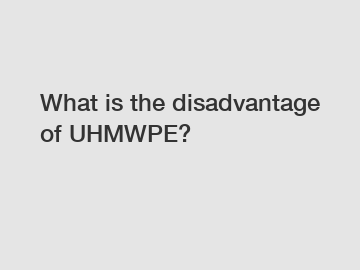Mar. 25, 2024
HUAZHONG supply professional and honest service.
HUAZHONG Product Page
Ultra-high molecular weight polyethylene (UHMWPE) is a versatile and durable material that is widely used in various industries, including aerospace, automotive, and medical. It offers a range of benefits, such as high impact strength, excellent abrasion resistance, and low coefficient of friction. However, like any material, UHMWPE is not without its disadvantages. In this blog post, we will explore some of the drawbacks of UHMWPE and how they can impact its performance in different applications.

One of the main disadvantages of UHMWPE is its poor resistance to UV radiation. When exposed to sunlight for extended periods, UHMWPE can degrade and lose its mechanical properties. This can be a significant issue for outdoor applications, such as marine equipment or playgrounds, where the material is exposed to the sun's harsh rays. To mitigate this disadvantage, additives can be incorporated into the UHMWPE to improve its UV resistance. However, this can increase the cost of the material and may not completely eliminate the problem.
Another drawback of UHMWPE is its low thermal conductivity. This can be problematic in applications where heat dissipation is important, such as in automotive components or industrial machinery. UHMWPE has a low thermal conductivity compared to other materials, which means it can trap heat and lead to overheating. In some cases, this can result in premature failure of the UHMWPE components. To address this issue, additional cooling systems may be required, adding to the complexity and cost of the overall system.
Furthermore, UHMWPE has poor adhesive properties, making it difficult to bond to other materials. This can limit its use in applications where strong bonds are required, such as in adhesive tapes or composites. Specialized surface treatments or adhesives may be needed to improve the adhesion of UHMWPE to other materials, increasing the complexity of the manufacturing process. Additionally, the lack of adhesion can result in weaker joints or seams, reducing the overall strength and durability of the final product.
In addition, UHMWPE has a low melting point, which can be a disadvantage in high-temperature applications. When exposed to elevated temperatures, UHMWPE can soften and lose its mechanical properties, leading to deformation or failure. This limits its use in applications where high temperatures are common, such as in automotive engines or industrial ovens. To overcome this limitation, additives can be used to increase the material's heat resistance. However, this can impact other properties of the UHMWPE, such as its impact strength or wear resistance.
Another drawback of UHMWPE is its susceptibility to chemical attack. While it has good resistance to most chemicals, certain substances can cause degradation or swelling of the material. This can be a concern in applications where UHMWPE comes into contact with aggressive chemicals, such as in chemical processing equipment or storage tanks. In these cases, alternative materials with better chemical resistance may be more suitable.
Despite these disadvantages, UHMWPE remains a popular choice for many applications due to its excellent mechanical properties and cost-effectiveness. By understanding the limitations of UHMWPE and taking appropriate precautions, engineers and designers can optimize its performance in various applications. Whether it's addressing UV resistance, thermal conductivity, adhesion, melting point, or chemical resistance, there are solutions available to overcome the drawbacks of UHMWPE and maximize its potential in diverse industries.
Click here to get more.
Previous: Maximizing Efficiency and Durability with HDPE Mining Pipe
Next: None
If you are interested in sending in a Guest Blogger Submission,welcome to write for us!
All Comments ( 0 )